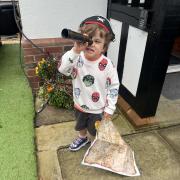Frank Pleszak, author and blogger about Lancasters and the Avro company that made them, tells the story of the Cheshire airman honoured for helping to save the lives of starving civilians in the Netherlands in World War Two
John Monagahan is sprightly, affable and full of charm, with an infectious energy that defies his 98 years. He’s a WW2 veteran, an inspiration, and a living testament to the enduring vitality of the human spirit. But, he’s a modest, quiet soul who doesn't appreciate unnecessary attention or fuss and considers he was only doing his job and nothing special in the Second World War.
John though, served in one of the most dangerous wartime roles, he was a radio operator on a Lancaster bomber. Seventy-eight years on, his involvement in one particular mission was recognised when he received a medal for one of the most important but least-known missions of the Second World War. It wasn’t for dropping deadly explosives from his Lancaster bomber but for dropping food supplies on one of the first airborne humanitarian aid missions by the Royal Air Force.

Early last year I worked on a large exhibition to commemorate the 80th anniversary of the Dambusters Raid of 1943, which also used Lancasters constructed and converted at Avro’s Woodford aerodrome, coincidentally just a few miles from John’s home in Poynton.
Avro became part of Hawker Siddeley, then British Aerospace, and eventually BAE Systems but sadly, Woodford ceased to be an aerodrome in 2011. The site is now a new housing estate, but the Avro Heritage Museum was established there and has some fantastic exhibits including a full-size Vulcan bomber and numerous cockpits including a replica of the forward section of Lancaster fitted out with all the original equipment including the huge radio equipment John would have used all those years ago.
The Dambuster exhibition was led by Ian Peat, an ex-BAE Systems employee and member of the Avro Heritage Museum’s management team. When I suggested I bring John to the museum and chat with him sat in his radio position in the Lancaster he was enthusiastic about the idea and the Avro Heritage Museum delighted to host the event.
I discussed the idea with John’s son Andy, who thought it was a great idea even though I was concerned about getting John into the Lancaster up the steep steps, through a small door, and over the main wing spar that obstructed the route to the radio operator's position. Andy knew his dad well and had no such concerns about his ability to negotiate any of those obstacles.
Andy told me a little about his dad who flew with 166 Squadron (Sqn). In preparation for the chat, I obtained the ORB (Operations Record Book) for the squadron and Andy sent me John’s flying logbook. I was astounded at what I saw.

John was born on the 18th of March 1925 and was not even 19 years old when he joined the RAF in late 1943. After qualifying to be an air radio (wireless) operator his training throughout 1944 included Avro Ansons, which were also made at Woodford, then the twin-engine medium bomber the Vickers Wellington, before graduating to the Avro Lancaster with 1656 HCU (Heavy Conversion Unit) in the January of 1945.
The role of the wireless operator was to manage all messages to and from the aircraft and its base. They operated, tuned, and maintained all the wireless equipment in the aircraft when on operation and used both plain messages and Morse code. As operations were generally conducted in radio silence, they had fewer tasks than the other crew members, so they were also trained as an air gunner to act as reserve gunner if needed.
After a couple of months of intense training with 1656 HCU John was posted as a fully qualified wireless operator to a mainly Canadian crew with 166 Sqn based at RAF Kirmington in Lincolnshire.
Though it was towards the end of the war John was to participate in some of the most incredible missions, several of which are not well documented. His first mission was less than a week before his 20th birthday on the 12th of March 1945. It must have been terrifying.

The target was Dortmund deep in the heart of Germany, and to make it more treacherous it was in daylight. John’s aircraft was AS-S (166 Sqn code) and one of 28 Lancasters provided by 166 Sqn. They were airborne at 13:10 carrying one 4,000lb high explosive ‘cookie’ bomb, 12 500lb and four 250lb high explosive bombs. Despite one of 166 Sqn’s Lancasters having to turn back to base when it had a problem with one of its engines the others, escorted by RAF Spitfires and Mustangs, arrived at the target without incident. Dortmund was obscured by cloud and protected by heavy anti-aircraft defences. John’s aircraft released its bomb load at 16:35 from a height of 17,500 feet directly on their blue marker Target Indicators. John landed safely back at base at 19:00 after nearly six stressful hours.
John completed more successful ops to Herne, Misburg, Hildesheim, and Hanover in March. This was followed in April by Nordhausen, Potsdam, Bremen and the heavily fortified German island of Heligoland in the North Sea. His last offensive bombing op was on the barracks of a local SS detachment at Hitler’s Bavarian home (Eagles Nest) at Berchtesgaden.
Though John was late into the action of WW2 he was on some incredibly important missions. Most crews were not assigned a dedicated Lancaster but John regularly flew with AS-J, which he affectionately referred to as J-Jig (the WW2 British phonetic for the letter J).

Significantly, John’s logbook for April interspersed with his bombing ops has a couple of entries, undertaken in a different Lancaster to J-Jig, entitled ‘Practise Supply Dropping’. These were a prelude to one of the most unbelievable bombing missions undertaken by the Allies in the whole of World War II. Instead of dropping bombs that caused death and destruction, the four-engine British Lancaster bombers were going to drop lifesaving supplies and rations for salvation and mercy.
The background to this had started the previous year on the 27th of September when the ambitious Operation Market-Garden had failed in the Netherlands. Its objective had been to secure bridges over the rivers Maas (Meuse), Waal, and Rhine to outflank heavy German defences along the Siegfried Line and to ensure a swift Allied advance towards Berlin. As most of us know this failed with A Bridge Too Far, at Arnhem. The Allies' advance simply bypassed the Netherlands effectively isolating the north and west areas of the country, which remained occupied by German forces.
With the onset of winter, German occupation, a naval blockade, lack of fuel, and limited food supplies the Dutch suffered what is known as the Hongerwinter (hunger winter). Around 20,000 people had already died through starvation, a further 980,000 were classed as malnourished, and there were fears of mass starvation. Almost immediately messages were received in London from occupied Holland stating there were only enough food supplies for several weeks.

The German occupiers faced significant challenges in supplying sufficient food resources, leading to negotiations between the Allies and German officers in charge of the occupied Netherlands. Swiss and Swedish emissaries played a crucial role in facilitating an agreement for humanitarian food drops, which became known as Operation Manna.
The missions were to be conducted with the understanding that aircraft would not be attacked by the German occupiers who still had many anti-aircraft artillery batteries positioned to shoot at Allied bomber formations on their raids over to Germany.
A truce was planned for the humanitarian effort to allow the Allied aeroplanes to fly at very low level to six specific drop zones via defined air corridors to deliver the much-needed supplies without any interference. The German occupiers placed anti-aircraft guns at each drop zone so they could immediately react if the allies used the humanitarian drop as a pretext to deliver paratroopers instead of food. German authorities would also inspect samples of the dropped supplies to verify it was indeed food supplies and not weapons or items that could be used for sabotage.
Arrangements were in place by April of 1945 hence why John, with 166 Sqn, and other squadrons had practised low-level supply dropping. Lancaster bombers were modified to carry the life-saving supplies in their bomb bays instead of bombs. Each Lancaster would carry 284 hessian sacks of supplies containing items such as flour, margarine, cheese, dried egg, peas, carrots, dried food, tea, coffee, cigarettes, and other essential provisions.

By the 24th of April, the possibility for the food drops had become a reality and expectations were high. Dutch authorities had to rapidly arrange for collection teams to gather and distribute the supplies and First Aid Posts that were located nearby just in case anybody was injured by falling supplies in their desperation to get to them.
The operation coded Manna (from the book of Exodus when God provided food from heaven) was scheduled to start on the 28th of April, but bad weather prevailed.
The operation began in earnest on Sunday the 29th although the truce though had not been fully agreed. During the morning to test the feasibility of the operation and the response from the German anti-aircraft teams, two Lancasters from 101 Sqn made the potentially perilous flight. It went unhindered, their supplies successfully dropped. At lunchtime, with the truce still not in place, 166 Sqn provided five Lancasters for the first mission.
One of the Lancasters was J-Jig with John Monaghan onboard. Airborne at 12:15 the Lancaster proceeded southeast over the North Sea at low level navigating through difficult thick cloud and sleet and snow showers. Their designated ‘safe’ corridor took them over the Hook of Holland and then north to the Hague where Pathfinder squadron Mosquitos had marked the dropzone at Duindigt Racecourse with red TI marker flares.
Fortunately, the cloud had lifted over Holland and though it was planned to make the drop from no higher than 500 feet the Lancasters released their stores as low as possible to reduce impact damage as no parachutes were being used. J-Jig released its supplies at 13:15 and the Germans made no attempt to stop or disrupt the mission. John and J-Jig returned to RAF Kirmington safely at 15:05. On that first day, almost 535 tons of supplies were dropped.
The truce was finally agreed on the 30th of April, Operation Manna lasted 10 days and John in his beloved J-Jig went on to make a further five trips, all to the drop zone at Rotterdam’s Waalhaven airfield. Together with the US Air Force involvement, known as Operation Chowhound (which started on the 1st of May), nearly 7,000 tonnes of food supplies were dropped with more than 3,000 sorties. On the 2nd of May, a further ground-based relief mission, Operation Faust was also launched. It is estimated that without all that humanitarian aid a further million Dutch civilians could have starved.
The Dutch were enthusiastic in their gratitude. Many of the aircrew record being tearful seeing the happy recipients waving flags and making impromptu thank you signs from the empty sacks that could be seen from the low-flying Lancasters. The RAF did not consider Operation Manna flights to be combat missions and didn't give the crews credit for flying them. Though they were clearly less difficult and were, certainly following the truce, less dangerous than normal bombing missions, they were still difficult and required the utmost skill and dedication of all the crews involved.
The war in Europe ended on the 8th of May and with it came the end of Operation Manna. John was soon back in the air. He was to take part in two more little-known but highly significant operations. On May the 10th and 11th he was involved in Operation Exodus, flying to Melsbroek Aerodrome in Brussels to bring home British former prisoners of war from northern Europe in Lancasters hastily converted into very uncomfortable, and cramped troop carriers. During August, September and October John also made six repatriation flights to Pomigliano Airbase near Naples as part of Operation Dodge, bringing home British soldiers from the Mediterranean area.
He also participated in the little-known Cook’s Tours whereby Lancaster crews flew low level over several bombed German cities to review the damage from the air. John’s final flight in Lancasters was in November of 1945. He was then posted from 166 Sqn to 5 ANS (Air Navigation School) in Yorkshire where he once again flew in the lovely Avro Anson. He finally left the RAF in 1947.
It was incredible listening to John's stories on his visit to Avro Avro Heritage Museum. He mentioned seeing the crowds of cheering civilians when he was on Operation Manna but two other memories really stuck out. The first was that while on Operation Manna, he and his crew took their own supplies of chocolates and sweets and during the drop they would have the back door of the Lancaster open and throw the chocolate out. He even remembers the chocolate was Terry’s Empire Chocolate. The second was again on Operation Manna, and it was when he was flying so low over the drop zones he could clearly see the German soldiers with their anti-aircraft guns watching them, normally on his bombing missions they would only have been represented by flashes of light 20,000 feet below.
After we had concluded the chat I published a blog that included several clips from the video recording and Ian Sanders (award-winning podcaster, Cold War historian and Fellow of the Royal Historical Society), published the entire discussion as a podcast. The comments and thanks we received to these clearly demonstrated just how much of a significant story he had told, but also just how important it was to record talks such as this told in their own words for posterity. It’s really the last opportunity to obtain such, so we need to ensure we can get as many as we can before it’s too late.
As chance would have it, the Dutch Embassy in London became aware of the blog and while John didn’t consider he’d done anything special and was only doing his job, the Dutch thought otherwise. Despite it being almost 80 years since the operation was mounted, the people of the Netherlands have never forgotten the great sacrifice and dedication of those aircrew that had risked their lives to get much-needed food to the starving civilians. John’s son Andy was contacted by Wing Commander Martine Verhulst, the Air Attaché to the Embassy of the Kingdom of the Netherlands, stating her government would like to recognise John’s past contribution to the people of her country by awarding him the unique Thank You Liberators Medal.
On December 13, last year Wg Cdr Verhulst and members of the Dutch Embassy staff met John Monaghan at the Avro Heritage Museum to thank him on behalf of the people of the Netherlands.
She told him: 'THE PEOPLE OF THE NETHERLANDS WILL FOREVER REMAIN GRATEFUL AND WILL NEVER FORGET THE BRAVE MEN AND WOMEN WHO TOOK PART IN THE LIBERATION OF THE NETHERLANDS. THANK YOU SO MUCH.'
John then reluctantly said a few words: 'I suppose I’ll have to say something. I accept this award, particularly on behalf of all my colleagues who took part in that Manna exercise, but not only them but all the aircrews that used these wonderful Lancaster bombers during the war. They were a great help to us, not only getting there and doing our stuff but getting back. Oh, I could go on and on. Thank you all for coming.'
Following the ceremony, the guests were invited to have a look around the museum and John was keen to show them inside the Lancaster cockpit. Interestingly, a delegate from the Dutch embassy mentioned one of their grandparents had told them they had been at one of the Operation Manna drop zones and collected bars of chocolate thrown from Lancasters. Maybe they were from John’s.
John’s son, Andy, left us with the sobering thought that at 98, John is now one of a very small group of possibly less than 20 men still living who saw active service with Bomber Command during the war and able to tell their stories first hand.
This year, as John moves into his 100th year, so too does the Woodford site. There will be a large exhibition to commemorate the centenary of Woodford and the hope is that John will be there to help celebrate what will be a unique event.
*Many thanks to the Avro Heritage Museum, Terry Barnes, Ian Peat, Roger Yates, and Ian Sanders, Andy Monaghan, Ian Font, Wg Cdr Martine Verhulst and the Embassy of the Kingdom of the Netherlands in London, and to Keith Gordon for being our photographer. But especially big thanks to John for eloquently sharing his experiences.
Blog
pleszak.blog/2023/08/18/john-monaghan-avro-lancaster-wireless-operator-interview/
Podcast
podcasters.spotify.com/pod/show/avro-heritage-museum/episodes/World-War-2-Avro-Lancaster-radio-operator---John-Monaghan-e28h6p4/a-aa9di9j



























